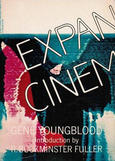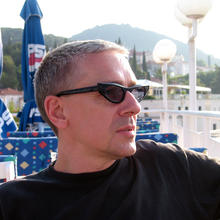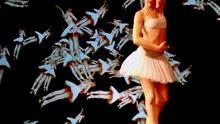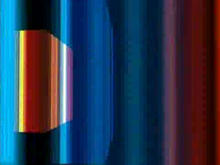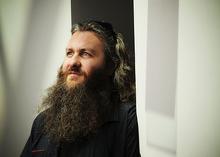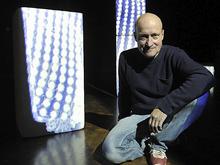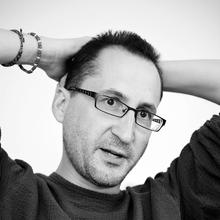Apparition
(2004)is an interactive dance and media performance conceived and directed by Klaus Obermaier, in collaboration with the Ars Electronica Futurelab, featuring Desirée Kongerød and Rob Tannion.
Conceived and directed by Vienna-based cross-media artist Klaus Obermaier in collaboration with the Ars Electronica Futurelab, Appariation is a unique dance and media work that fully confronts the aesthetic potential and consequences of integrating interactive technologies with live performance on the stage. Working closely with Klaus Obermaier is an international team including London-based dance artists Rob Tannion and Desirée Kongerød and interaction designers and programmers Christopher Lindinger and Peter Brandl (from the Ars Electronica Futurelab). Development of the system for motion tracking and analysis was provided by Hirokazu Kato from Japan.
New technologies whether mechanical, chemical or electronic have always made their way into the performing arts; and in the mid 20th century artists began to explore the integration of media technologies with live performance. Two who are most often cited from this period are Czech scenographer Josef Svoboda whose understanding for the kinetic properties of space resulted in inspirational combinations of film and live performance on stage; and renowned American choreographer Alwin Nikolais whose use of multimedia on stage challenged the dancers to explore the space and movement in new ways. These two artists established precedents for the integration of media and live performance on stage that can be traced through the increasingly diversified work of a range of theater and dance makers including: Robert Lepage (Canada), Wooster Group (USA), William Forsythe (Germany), Marcel.li Antonio Roca (Spain), Dumb Type (Japan), Hotel Proforma (Denmark), Blast Theory and Station House Opera (United Kingdom).
This helps to provide the context for a series of stage works devised by Apparition director Klaus Obermaier beginning with the production of D.A.V.E. (1998-2000). Devised in collaboration with dance artist Chris Haring, D.A.V.E. was a solo dance theater work using a unique approach to moving body projections that fused body and image into a consistent narrative. Following the success of D.A.V.E. (having performed to date eighty shows in eighteen countries), Klaus Obermaier and Haring embarked on the creation of another media and dance performance work, Vivisector (2002), that placed four dancers on the stage and used a reduced technique of body projection to explore the limitations of perception.
Neither of these works used interactive technologies, but relied on a creative and precise combination of set choreography, staging and recorded video. Having experience with interactive artworks since 1991, Klaus Obermaier decided to further develop the aesthetics of body projection by making a piece that would use interactive technologies to release the performer from the determination of set choreography and would use digital media performance software to generate the video and sound content in real-time. Discussions with engineers and designers at the Ars Electronica Futurelab about building the interactive and real time generation system, and involvement in the organisation of the DAMPF_lab (a European joint performing arts/ technologies research project) stimulated the initiation of the Apparition project.
The creation of a performance work for the stage involves a complex interplay between many factors including the performers’ physicality and the dynamics of emergent choreographic forms. To closely reflect this, the real-time system for generating visuals developed for Apparition is built on top of computational processes that model and simulate real-world physics. The inherent kinetic properties of these simulations inspired our view that the overall interactive system is much more than simply an extension of the performer, but is a potential performing partner. The independent behavior of the physical models for example is not ‘controllable’ by the performer, but can be influenced by his or her movement. This interplay between dancer and system and how one begins to understand the properties of the other has been crucial to the conceptual and aesthetic development of the work; helping give shape to the choreography and underpinning its dramaturgy.
The camera based motion tracking system developed for Apparition uses complex computer vision algorithms to extract the performer’s moving outline/ shape from the background to provide constantly updating information for a body projection as well as qualitative calculations of certain motion dynamics, e.g. speed, direction, intensity and volume. The information derived from these calculations is assigned dynamically to the real-time generation of visuals that are projected either directly back onto the body and/ or as large-scale background projection. The precise synchronisation of projections on the background and the bodies result in the materialization of an overall immersive kinetic space / a virtual architecture that can be simultaneously fluid and rigid, that can expand and contract, ripple, bend and distort in response to or an influence upon the movement of the performers.
These two main areas of research, the system as performance partner and the immersive kinetic space, have provided a framework for developing material that closely links the interactive system, real-time generated visuals and performance. There is no assumed hierarchy of systems and choices have been made that maximize associative and metaphorical linkages across computational, emotional and corporeal processes. This work is fundamentally unlike an interactive installation with its focus on the engagement of every day users and participants. Apparition stresses resonances between virtuoso performer and sophisticated computation and media processes and contributes specifically to the evolving aesthetic in the genre of interactive stage performance. (Scott deLahunta)
Source: Klaus Obermaier
